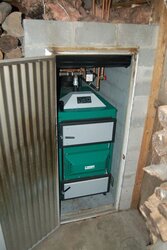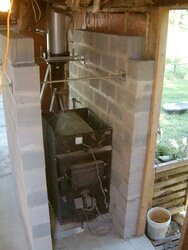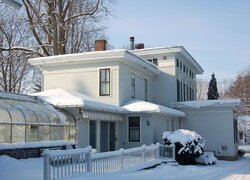My wife and I have built two homes on our sixty acre ranch near Elbert, Colorado on the Palmer Divide. We built in a wooded area and so we have unlimited supplies of downed timber for firewood. Our first home (now our guest quarters) was a hybrid straw bale design. It is small and takes almost nothing to heat it. Our small Lopi wood stove could run you out on the coldest of days. We built our second home completely of surplus materials. It is well insulated (8" cellulose filled walls with two layers of 5/8" osb sheathing, red cedar siding and a wainscot of natural stone. It has a concrete tile roof. It is framed in steel. We put radiant heat in the floor. We have a propane Burnham boiler with a side arm that heats our hot water. We want to add a gasification boiler in the garage. Being on a fixed income, skyrocketing propane costs are taking a bite out of the budget. Gasification seems a logical choice for us. With that introduction in mind, I have several rather complex questions:
1. I am currently heating 2,500 s.f. and I would like to eventually consider adding an arm to our 1,000 s.f. green house. We average $100 per month on propane now with the 136,000 btu Burnham. Should I go for a larger gasification boiler in terms of btu's?
2. I am down to either an EKO or Biomax out of W.V. and I have had some interest in a Greenwood. I was a bit discouraged about troubles expressed in this forum over the cracking in the masonry lining of the Greenwood. Is one of these units substantively better than the other? Since I will be doing most of the plumbing myself, is one of these brands more complicated (in terms of installation) than the others?
3. I am going to frame in a boiler room in my attached garage. Can clearance distances be safely reduced by lining the boiler room with cinder block? Also, fresh air is an obvious consideration in a boiler room. Is it feasible to force air into the BR based on the burn requirements? This question will obviously prove that while I will try to build anything under the sun, actually knowing what I am doing does not get in my way;-) .
4. Should wood storage be outside of the BR?
I am including a picture of our home. My wife and I did all of the work ourselves and it is something of which we are very proud. Now if we can just heat it with a gasification boiler, we might finally be able to get on with retirement dreams.
Robert

1. I am currently heating 2,500 s.f. and I would like to eventually consider adding an arm to our 1,000 s.f. green house. We average $100 per month on propane now with the 136,000 btu Burnham. Should I go for a larger gasification boiler in terms of btu's?
2. I am down to either an EKO or Biomax out of W.V. and I have had some interest in a Greenwood. I was a bit discouraged about troubles expressed in this forum over the cracking in the masonry lining of the Greenwood. Is one of these units substantively better than the other? Since I will be doing most of the plumbing myself, is one of these brands more complicated (in terms of installation) than the others?
3. I am going to frame in a boiler room in my attached garage. Can clearance distances be safely reduced by lining the boiler room with cinder block? Also, fresh air is an obvious consideration in a boiler room. Is it feasible to force air into the BR based on the burn requirements? This question will obviously prove that while I will try to build anything under the sun, actually knowing what I am doing does not get in my way;-) .
4. Should wood storage be outside of the BR?
I am including a picture of our home. My wife and I did all of the work ourselves and it is something of which we are very proud. Now if we can just heat it with a gasification boiler, we might finally be able to get on with retirement dreams.
Robert




